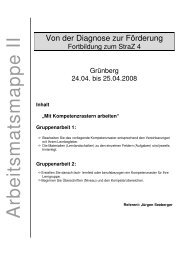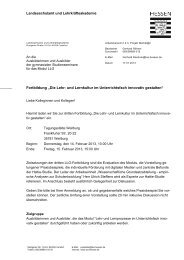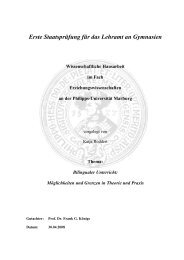PROFILING EUROPEAN CLIL CLASSROOMS
PROFILING EUROPEAN CLIL CLASSROOMS
PROFILING EUROPEAN CLIL CLASSROOMS
You also want an ePaper? Increase the reach of your titles
YUMPU automatically turns print PDFs into web optimized ePapers that Google loves.
RATIONALE<br />
European <strong>CLIL</strong> is highly diverse with many different ‘types’ 1 commonplace. Although<br />
different, such ‘types’ have much in common because the reasons for doing <strong>CLIL</strong>, what<br />
we call the dimensions, are inter-linked in <strong>CLIL</strong> practice.<br />
This first version of Profiling European <strong>CLIL</strong> Classrooms results from a research-driven<br />
project which has focussed on identifying the dimensions of <strong>CLIL</strong>. It aims to be comprehensive<br />
but not exhaustive. Just as it identifies the foundations, so it is itself, a foundation by which<br />
to build greater understanding of the potential of <strong>CLIL</strong>.<br />
Insight into the dimensions of <strong>CLIL</strong> practice allow us to identify the core principles of this<br />
educational approach as it is done in very different European contexts.<br />
There are 5 dimensions based on issues relating to culture, environment, language,<br />
content and learning. Each of these includes a number of focus points realized differently<br />
according to 3 major factors: age-range of learners, socio-linguistic environment,<br />
and degree of exposure to <strong>CLIL</strong>.<br />
The dimensions are idealized and should not be viewed as ‘standing alone’, because they<br />
are usually heavily inter-related in <strong>CLIL</strong> practice. This means that in real-life implementation<br />
of <strong>CLIL</strong>, it is likely that a school will wish to achieve successful outcomes in relation to<br />
more than one dimension at the same time.<br />
However, it is useful to distinguish the dimensions because it allows us to identify the<br />
separate, yet inter-locking reasons why <strong>CLIL</strong> is implemented in diverse European<br />
contexts. Just as each dimension inter-locks with others, some dimensions are more<br />
‘transient’ than others, in that the main reason for doing <strong>CLIL</strong> in a school, or within a<br />
class, may change over time. For example, a school might start <strong>CLIL</strong> in order to enhance<br />
its profile and attract students, and then move onto another such as improving learners’<br />
overall target language competence.<br />
Profiling European <strong>CLIL</strong> Classrooms contains an introduction to the <strong>CLIL</strong> dimensions<br />
and focuses. Inter-linked with this publication is an Internet site. The <strong>CLIL</strong> Compendium<br />
(www.clilcompendium.com) provides a more detailed and comprehensive description<br />
of the realization of diverse examples of European <strong>CLIL</strong>.<br />
1 Types and models tend to be rather static descriptors of practice. The use of such terms often suggests<br />
that an established way of doing something exists, which has been tested, and which is implemented<br />
according to certain principles. If a system is used as a type or model, then people are likely to copy it in<br />
order to achieve similar results.<br />
17
















